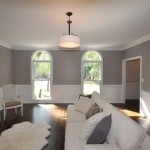Projector TVs in the Living Room
Projector TVs offer a compelling alternative to traditional flat-screen televisions, bringing a cinematic experience into the comfort of one's home. Their ability to project images onto a much larger surface allows for an immersive viewing experience that surpasses the limitations of standard screen sizes. This article explores the various aspects of integrating a projector TV into a living room setting, covering key considerations from setup and ambient light control to screen options and sound integration.
Choosing the Right Projector
The first step in creating a home theater experience with a projector is selecting the right projector for the living room environment. Key factors to consider include resolution, brightness (measured in lumens), throw ratio, and contrast ratio. For optimal viewing, a minimum resolution of 1080p (Full HD) is recommended, while 4K resolution offers even greater clarity and detail. Brightness is crucial, especially in living rooms with ambient light. Higher lumen values ensure a vibrant image even in less-than-ideal lighting conditions. Throw ratio determines the projector's placement relative to the screen size, dictating the required distance for a specific image size. Finally, contrast ratio affects the depth and richness of the image, impacting the clarity of dark scenes and the overall visual impact.
Different projector technologies exist, each with its strengths and weaknesses. DLP (Digital Light Processing) projectors are known for sharp images and high contrast ratios, making them suitable for environments with some ambient light. LCD (Liquid Crystal Display) projectors often provide more vibrant colors and smoother images, while LCoS (Liquid Crystal on Silicon) projectors combine the benefits of both DLP and LCD technologies, offering high contrast, good color accuracy, and sharp images. Considering these factors helps determine the most appropriate projector technology for the specific living room setup.
Optimizing the Viewing Environment
Once the projector is selected, optimizing the living room environment for projection is crucial. Ambient light control plays a significant role in image quality. Minimizing light sources, such as windows and overhead lighting, can significantly enhance the viewing experience. Blackout curtains or blinds can effectively block out external light, while dimming switches allow for controlled adjustments of internal lighting. These measures contribute to deeper blacks, richer colors, and a more immersive viewing experience.
Selecting the appropriate screen is another critical element. While a blank wall can suffice, a dedicated projector screen significantly improves image quality. Screen materials vary, impacting brightness, contrast, and viewing angles. Consider factors such as gain (reflectivity), screen size, and aspect ratio to optimize the projected image. Motorized screens offer convenient storage and deployment, while fixed-frame screens provide a consistently taut surface for optimal image clarity. Matching the screen's characteristics to the projector and room dimensions is essential for achieving the desired viewing experience.
Integrating Sound and Other Components
Completing the home theater setup involves integrating a suitable sound system. Projectors often lack powerful built-in speakers, necessitating external audio solutions. Soundbars, surround sound systems, or even headphones can enhance the audio experience. Connecting the audio source to the projector or directly to the sound system ensures synchronized audio and video. Consider the room size and acoustics when selecting a sound system to achieve optimal audio performance.
Connecting other components, such as Blu-ray players, streaming devices, and gaming consoles, further expands the projector's functionality. HDMI cables are typically used for high-definition video and audio transmission. Ensuring sufficient HDMI ports on the projector or using an HDMI switcher allows for seamless integration of multiple devices. Organizing cables and concealing them within walls or cable management systems contributes to a clean and aesthetically pleasing setup. Proper cable management also prevents signal interference and tripping hazards.
With careful planning and execution, a projector TV can transform a living room into a captivating entertainment hub. From selecting the appropriate projector and screen to optimizing ambient light and integrating a robust sound system, each element contributes to the overall immersive experience. By addressing these key considerations, viewers can enjoy a cinematic experience that surpasses the limitations of traditional television viewing.

A Home Cinema In Your Living Room The Ultimate Guide

Home Theater Projector Or Tv Which Screen Is Right For You Blog

Tvs Vs Projector Which Picture Technology Should You Choose Techradar

Projector Screens Mirror Tv S Creative Mounts Modern Family Room Miami By First Priority Audio Houzz

Projectors Vs Tvs Which Is Best For Your Home Theater Digital Trends

Projector Or Tv The Best Choice For Your Living Room

Choosing The Perfect Ultra Short Throw Projector Key Questions To Ask

5 Projector In Living Room Set Up Ideas Wewatch

Projector Or Tv The Best Choice For Your Living Room

Ultra Short Throw Projector Vs Big Screen Tvs Wirecutter








